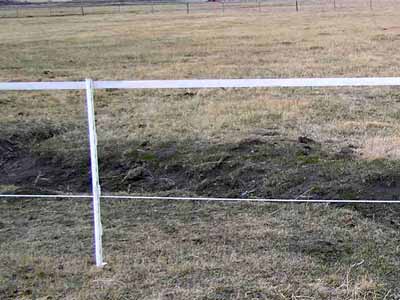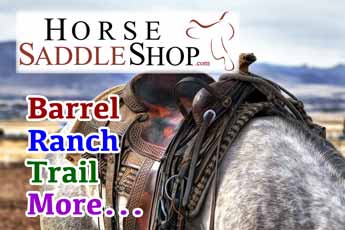By guest author Ashley Reynolds for CentaurFencing.net.
Electric Fencing in Rotational Grazing
One of the most effective ways to raise horses on a limited plot of land is through rotational grazing.
What Is It?
Rotational grazing is where you divide a field into smaller pastures for your horses to graze. This way you can control how much wear your fields are having to endure. It also prevents overgrazing in the "sweet spots" and huge areas of your field under-grazed.
Why?
Fencing these pastures with permanent fences can cost a significant amount of money and once it has been divided there is no turning back without a significant investment of time, effort, and money. So what can you do?
How?
One of the easiest ways to fence areas off for rotational grazing is by using hotwire or electric fencing. These fences go up quickly and are inexpensive and can be moved and shaped to your desired location in minutes.
You will need:
- A charger for your fence and possibly a booster if you have an exceptionally large acreage to fence
- Electric fencing
- Posts (you can buy insulators to attach to wooden stakes or you can get premade plastic posts)
- Connectors to join the fencing
- Gate handles
(Try www.centaurfencing.net for energizers and fencing.)
Below: An electric fence in the form of ribbon "wire."

Image Attribution: By BLW (Own work) [GFDL (http://www.gnu.org/copyleft/fdl.html), CC-BY-SA-3.0 (http://creativecommons.org/licenses/by-sa/3.0/) or CC BY-SA 2.5-2.0-1.0 (http://creativecommons.org/licenses/by-sa/2.5-2.0-1.0)], via Wikimedia Commons.
Setting Up Rotational Grazing
There are a few things you will want to remember when using electric fencing in this way, however. You will want to make sure that you use a wide ribbon "wire" instead of a single line as it is much more visible to a horse and less likely to be run through. They are also more likely to break should your horse run through them instead of slicing through your horse's chest or wrapping around their legs. You will want to run this with a minimum of a top and bottom strand to maximize visibility although fences of 3-4 strands are preferable.
Setting these fences is easy. You will want to plan out your pasture's layout before buying the supplies to erect the fencing. One easy design that requires the least amount of change is to divide your rectangular field in half with a six to eight foot "lane" down the center. This is where all the paddocks will open to allow you easy access to every paddock and reducing the number of paths being worn into your field.
From there, have the field divided into appropriately sized paddocks for the number of horses you want to place in them. Once this has been designed, plan where the openings will go. This can be easily achieved by using a gate hook. Simply pull on the insulated gate handle, open the wire "gate," and then lead your horse in or out.
Once this has been planned, you can determine what box will work best for you. Make sure you calculate the total fencing used, not just the perimeter, or you will have issues with a loss of voltage. This can be quite disastrous as some horses will occasionally check for a weak spot in the fencing. Once a horse has learned to run through an electric fence it is much harder to retrain them to respect it again.
Setting up the fence is quick and painless in comparison to installing a traditional fence. Often a 10-acre field can be divided into ten 1-acre paddocks in the course of a day with two people.
If you find one of the paddocks is looking quite bare, you can let that paddock rest and use one of the empty paddocks you have created. This type of rotational grazing ensures that your pastures are healthier, greener, and are more productive than if you left the whole pasture open. It is also ideal for horses that are prone to overgrazing or need to have their grass intake limited for medical reasons. You simply use one of the heavily grazed pastures where your horse will still benefit from being outside without the danger of overgrazing. You can also divide the paddocks to limit how much room a horse has if you need to. One useful product for dividing paddocks is the Gallagher Smart Fence.
When This Is Not The Way To Go
This type of fencing is appropriate for foals, mares, and geldings. It is not appropriate for stallions or wild horses as the electric current is not enough of a deterrent. They will still require a minimum of a 5-foot traditional fence made from planks, metal tubing, or other solid materials.
This article was contributed by guest author Ashley Reynolds for CentaurFencing.net and is being used with permission.
About The Author
At CentaurFencing.net they are passionate about horses. As they developed their business, it was their number one goal to provide the best quality products and merchandise at the absolute lowest prices in order to provide each individual horse owner with the opportunity to have a safe and beautiful environment for their horses. Please be sure to visit their website at CentaurFencing.net.
What Is / Are...
… What Are 5 Of The Biggest Wild West Robberies?
… What Are 5 Reasons Horse Trailer Lighting Matters?
… What Are 8 Dumb Things To Say To A Horse Lover?
… What Are 9 Proven Ways To Keep Flies Off Horses?
… What Are Chestnuts and Ergots?
… What Are The Parts Of A Western Saddle?
… What Are Saddle Rigging Positions?
… What Are Some Fencing Options?
… What Are Some Foods Both Horses And Dogs Can Eat?
… What Are Some Horse Fencing Basics?
… What Are Some Interesting Horse Facts?
… What Are Some Interesting Charts and Graphs With Horse Information?
… What Are Some Options For Temporary Horse Fencing?
… What Are Synthetic Saddles Made Of?
… What Are The Rodeo Catch Pens?
… What Are The 10 Best 3-Horse Trailers With Living Quarters In The USA And Canada?
… What Are The X's In A Cowboy Hat?
… What Are The Three Legal Head Catches?
… What Is The Angle System For Branding?
… What Is The Barrel Racing Pattern?
… What Is A Bull Riding Vest Made Of?
… What Is Deworming Your Horse?
… What Is A Domain Name?
Why would I need one for my farm or ranch even if I don't have or
want a website?
… What Is A Fifth Wheel Trailer Hitch?
… What Is Flag and National Anthem Etiquette At A Rodeo?
… What Is A Slant Load Horse Trailer?
… What Is Floating A Horse's Teeth?
… What Do Horse Freeze Brands Look Like?
… What Is A Galvayne's Groove?
… What Is A Gooseneck Trailer Hitch?
… What Is Some History About The First National Finals Rodeo?
… What Is The History Of The Modern, Hornless, Bronc Riding Saddle?
… What Is The History Of The Modern Rodeo Bucking Chute?
… What Is The History Of The One-Hand Bareback Rigging?
… What Is The Nasolacrimal Duct In Horses?
… What Is A Pony Express Mochila?
… What Is Hermann Oak Leather?
… What Is Larvicidal De-Worming?
… What Is The Flehmen Response?
… What Is The Rodeo Return Gate?
… What Is A Safety Tip For Posting The Colors?
… What Is A Slick Fork Saddle?
… What Is A Swell Fork Saddle?
You Might Also Like
